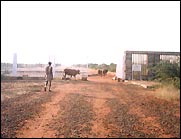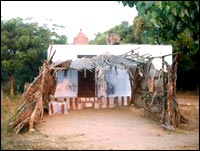Part 4
'India's interest is not electricity, but
nuclear bombs'
George Iype and S P Udayakumar
 Newcomers attract immediate attention in steaming Kundankulam. Enquiries about the nuclear power project pull a good crowd.
Newcomers attract immediate attention in steaming Kundankulam. Enquiries about the nuclear power project pull a good crowd.
Everyone is willing to talk. And, justifiably, anxious about their future.
It is in this village in Tamil Nadu that India's first nuclear power plant in more than a decade will come up. The Kudankulam Atomic Power Station, a $ 3 billion project, will be built in five years using the Russian VVER 1,000 reactors.
The people are bitter about how the government acquired land for the project. Compensation, they say, was pathetically inadequate -- just Rs 2,000 per acre and another Rs 100 for each cashew tree on the land.
There were tamarind trees too, which used to fetch them "approximately Rs 2,000 every year". The plots were taken in the 1980s -- and with it went the only asset that many families had.
Did the locals know what they were getting into when the land was taken? No. Many say they were not even told about the hazards of radiation.
Some were hopeful of swapping their land for government jobs. A decade later, they are slowly waking up to the reality that there won't be any jobs -- and worse, they might be evicted from the area.
THERE are, of course, people who are very enthusiastic about the project.
The reason could be that they have their eye on winning some contract or the other when the construction begins. The tension between these would-be-entrepreneurs and the anxious landless is very much visible.
Then there is a third group that continuously leaks Didn't-I-tell-you-so rhetoric. Hadn't they, they say, warned their fellow villagers to be careful about selling their land? Hadn't they said that no good would come to them out of it? Of course they had! And now look what is happening!
In the face of such divisions and confusion, civic courage gives way to superstition and resignation. The 'believers' point out that then prime minister Rajiv Gandhi, who signed the deal with the Soviet Union, was killed, and that H D Deve Gowda, who revived the project, lost his prime ministership immediately thereafter.
Besides the confused and the contended, there are a few groups in Kudankulam that are now actively opposing the project. Thangathurai Swami, who manages the Narayanaswami temple on his family land that lies inside the project compound, has steadfastly refused to sell his land.
 As he puts it, "I cannot sell my God and the temple."
As he puts it, "I cannot sell my God and the temple."
Muthukumaraswamy, a retired schoolteacher, has also said 'no' to the government. He filed a suit in the Tirunelveli district court. Besides highlighting the inadequate compensation, Muthukumaraswami says farming land and burial grounds should not be taken for industrial initiatives.
There is a group called the Nuclear Power Opposition Group in Kudankulam. Their activity, however, is limited to publishing occasional handbills.
IF Kudankulam is indecisive, the surrounding villages and towns are not any better.
There are many social service organisations in Meignanapuram, Nanguneri and in Kanyakumari, Tirunelveli, Thoothukudi and Madurai districts, but they are not fully into the fight against the plant.
In Kanyakumari district, the Social Action Movement carries out awareness campaigns. D Mathias of SAM and Reverend Y David of the Samathuva Samuthaya Iyakkam, loosely translated as Social Equality Movement, have been educating the public about the dangers of nuclear power projects since 1988.
The Palmyrah Workers' Development Society of Dr Samuel Amirtham and the Peace Association for Social Action of Dr Gnana Robinson are two other organisations that are in the fight.
The fear of radioactive contamination is what figures prominently in these groups' campaigns. Environmental dangers, health risks and nuclear waste disposal issues are also raised. The impending diversion of water from the Pechipparai Dam for the project is also a grave concern among the farmers of Kanyakumari district and adjacent areas.
The people are more or less certain that the government will go ahead with the project -- and if there is an accident, it would eventually be closed down.
"It is the general trend of our times that people ignore warnings but feel sorry and make amends when disasters strike," comments Dr S Thasan, a retired Tamil professor of Marthandam Christian College.
One reason why the movements have not really been successful is because they have failed to debate the alternatives to nuclear power in the larger framework of national development. Numerous windmills that produce electricity profitably surround the proposed site. Unfortunately, the protesters have not focussed upon the rewards of such renewable energy systems.
IT is true that the southern districts of Tamil Nadu are industrially backward and could use some economic boost.
But what do the people want? Do they want to depend on industries instead of the traditional agricultural? Are they interested in a modern 'big-bang' solution for the intractable problem of underdevelopment?
Ask these questions and you will get deafening silence.
Even as anti-nuke activists mount pressure on the authorities, many commoners say that some good will come out of it -- like, they will get continuous electricity, will they not?
"We have frequent power cuts here. The nuclear plant coming up there will make our fans run," says Murugappa Devan, looking at the motionless fan in his medical shop.
Residents like Devan have another hope -- that "the electricity factory" would bring jobs to their children.
In the past three years, officials of the Atomic Energy Commission have been educating the villagers about the benefits of nuclear energy. But doubts remain -- the VVER-type reactors are dangerous, claim anti-nuclear activists.
Project Director S K Jain, however, does not believe so. After a recent visit to Moscow, Jain is working hard to ensure that construction commences early in 2001.
Talk about the Chernobyl accident and Jain says: "It is not fair to always mention Chernobyl whenever we plan a nuclear power plant in the country. Environmental safety and people's health are our utmost priority. Kudankulam power project will bring us glory and lots of electricity."
Despite such claims there are questions that the Atomic Energy Commission has not answered.
Questions like why did the government opt for a multi-million nuclear power project when electricity could be produced safely from alternative sources from across Kudankulam and the neighbouring villages?
"India has given away Kudankulam to Russian experimentation because our government's interest is not in electricity but in promoting the country's secret nuclear designs," says Mallika Rajendran, a social activist in Kudankulam.
Rajendran says the authorities never conducted any study on the environmental impact of a nuclear project in a place like Kudunkulam, which is close to the sea.
"Radioactive contamination will spread like wild fire because Kudankulam has the largest number of windmills in the country," she says.
Rajendran and her colleagues are now making their final stand. Every day, they hold roadside public meetings in Kudankulam to present their case.
Work on the project, meanwhile, is expected to commence on schedule.
ON TO PART 5
Experts speak their mind!
Return to Darkness at noon
Page design: Dominic Xavier
Photographs: NPCIL



|

